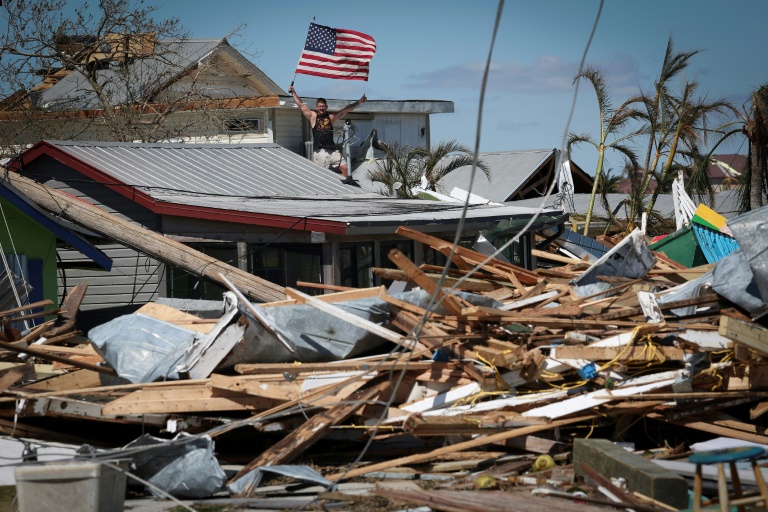Whitney Hall waves an American flag amidst the wreckage of his home in Matlacha, Florida
Hurricane Ian, one of the worst storms ever to hit the United States, roared into South Carolina on Friday, delivering a powerful second punch after walloping Florida.
The National Hurricane Center (NHC) said Ian made landfall near Georgetown, South Carolina, as a Category 1 hurricane with maximum sustained winds of 85 miles (140 kilometers) per hour.
It was later downgraded to a post-tropical cyclone but the NHC warned coastal residents that the “dangerous storm surge, flash flooding and high wind threat continues.”
As for storm-ravaged Florida, President Joe Biden said: “We’re just beginning to see the scale of the destruction.
“It’s likely to rank among the worst in the nation’s history,” he said of Ian, which barreled into Florida’s southwest coast on Wednesday as a Category 4 storm, a tick shy of the most powerful on the Saffir-Simpson wind scale.
CNN, citing state and county reporting, said the storm had left at least 42 people dead in Florida but state officials cited a figure of 21 and said 20 of those deaths had not been confirmed yet as storm-related.
Seventeen migrants also remain missing from a boat that sank during the hurricane on Wednesday, according to the Coast Guard. One person was found dead and nine others rescued, including four Cubans who swam to shore in the Florida Keys.
With damage estimates running into the tens of billions of dollars, Biden said it’s “going to take months, years to rebuild.”
“It’s not just a crisis for Florida,” he said. “This is an American crisis.”
CoreLogic, a firm that specializes in property analysis, said wind-related losses for residential and commercial properties in Florida could cost insurers up to $32 billion while flooding losses could go as high as $15 billion.
“This is the costliest Florida storm since Hurricane Andrew made landfall in 1992,” CoreLogic’s Tom Larsen said.
– ‘We made it through’ –
In Florida, rescue teams were assisting survivors on Friday and the Coast Guard said it had made 117 rescues using boats and helicopters of people trapped in flooded homes.
Governor Ron DeSantis said hundreds of other rescue personnel were going door-to-door “up and down the coastline.”
DeSantis said the coastal town of Fort Myers where the hurricane made landfall, was “ground zero” but “this was such a big storm that there are effects far inland.”
Many Floridians evacuated ahead of the storm, but thousands chose to shelter in place and ride it out.
More than 1.6 million Florida residents were still without electricity on Friday and two barrier islands near Fort Myers — Pine Island and Sanibel Island — were cut off after the storm damaged causeways.
More than 350,000 people were without power in North and South Carolina, according to tracking website poweroutage.us.
In Fort Myers, a handful of restaurants and bars reopened, giving an illusion of normalcy amid downed trees and shattered storefronts.
Dozens of people sat out on terraces under a bright sun, drinking beer and eating.
Dylan Gamber, 23, said he had been waiting for two hours at a pizzeria to get food to bring home.
“It was kind of bad, but we made it through,” Gamber said. “The roof of our house came off, a big tree collapsed across our vehicles, our yard was flooded, but other than that we were pretty good.
“As a community, we seem to be coming together and helping each other out.”
– ‘All submerged’ –
In nearby Bonita Springs, Jason Crosser, 37, was inspecting the damage to his store.
“The water went over the whole building,” Crosser said. “It was all submerged. It’s all saltwater and water damage.”
After making landfall in South Carolina, Ian is expected to weaken fast and dissipate by Saturday night.
Before pummeling Florida, Ian plunged all of Cuba into darkness after downing the island’s power network.
Electricity was gradually returning, but many homes remain without power.
Human-induced climate change is resulting in more severe weather events across the globe, scientists say — including with Ian.
According to a rapid and preliminary analysis, human-caused climate change increased the extreme rain that Ian unleashed by over 10 percent, US scientists said.









